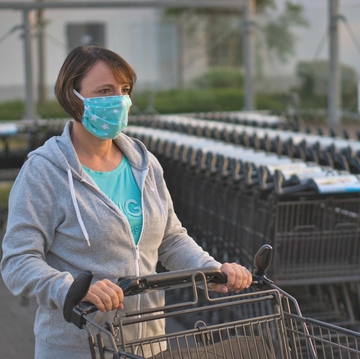New Mexico Approves Master of Science in Anesthesia Program at UNM

Wear it Properly
A Mask Should Always Cover Your Mouth and Nose
Now that face masks are required for some essential workers, and state health officials and the Centers for Disease Control and Prevention (CDC) are encouraging folks to wear one when out in public, it's important to wear it properly and to keep it clean.
"It's like a seatbelt, in that it only works if it's used properly," says Jonathan Skiles, RN, unit director at UNM Hospital.
The core advice remains the same: continue to stay home, wash your hands and practice social distancing to reduce the spread of COVID-19. And when you must go out, wear the mask so that it fits snugly over your nose and mouth.
How-Tos
To place it on your face, carefully grasp the loops on the side of the mask and place them around your ears, making sure not to touch the part that covers your nose and mouth.
- Keep the mask dry to prevent viruses from spreading. Germs are transported more easily through moisture, and when you breathe, you exhale moisture into the mask. When you touch the front of the mask, there's a higher chance of passing germs to your mouth and nose, Skiles explains. So make sure that you're only touching the loops of the mask.
- If you're new to wearing a mask - and most of us are - it's important to remember to take breaks. When you do so, remove the mask completely from your face. "Your face needs a break from the bands and pressure points it creates," Skiles says.
- After removing the mask, place it on a clean surface. Skiles keeps his masks in a clean container. "Protect the front of your mask as much as possible, especially when eating or drinking," Skiles says. Have a clean place for it.
- Surgical masks can be used several days as long as you let them air out between uses. If you're wearing a cloth mask, wash it in the washing machine every two days, or more often. You can also leave it in direct sunlight to kill the virus, he says. It's helpful if you have two masks, so that you can alternate using each one.
- Though it might be tempting to dampen the mask with water for a cooling effect as the weather heats up, germs are transmitted through moisture. Skiles recommends going to your office or outside for a break. Remove your mask to give your face some air, and drink some water.
The mask won't protect you if it only covers your mouth and not your nose. Skiles says he has seen people wear a mask so that it's hanging around the chin, or even on the forearm.
"There's no magical powers to the mask," he says.
The Centers for Disease Control and Prevention (CDC) provides step-by-step directions on how to make and care for a mask.